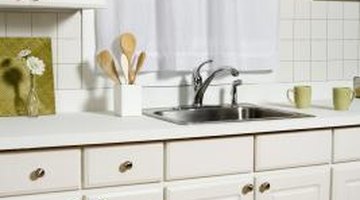How to Give Your Ikea Cabinets Extra Strength When Building Them
The relative strength of IKEA cabinets compared to their cost is an incentive toward the purchasing them rather than other brands. However, if you’re planning to store large amounts of dishware, heavy ceramics or tools, reinforcing the cabinet’s strength during installation is wise. IKEA sells the components necessary for increasing the strength, stability and safety of their cabinetry. The reinforcement should not significantly increase the installation time. When properly reinforced, IKEA cabinets provide many years of reliable service.
Adding Brackets

Step 1
Position three brackets on the cabinet’s interior pressed up against the bottom and rear boards. Mark the location of each screw hole with a pencil.
Step 2
Predrill holes at each marking, making nine holes in all. Do not completely drill through the cabinet board. Attach the brackets to the cabinet using wood screws.
Step 3
Repeat this process, installing two brackets into each side of the cabinet with the brackets pressed up against the side and the bottom boards. Use as many brackets as needed based on the weight of the objects you are storing and the general sturdiness of the cabinetry.
Installing Extra Suspension Rails
Step 1
Locate the studs in the installation wall and mark them with pencil in preparation for installing the suspension rails. Hold the suspension rail up to the wall and predrill one hole into each stud through the exposed holes in the suspension rail. Attach the rail to the wall with 3-inch wood screws.
Step 2
Repeat the suspension rail installation to install one or two more suspension rails parallel to the first and connected to the studs in the same fashion, 6 inches apart from each other. Attach the cabinetry to one of the suspension rails using the included sliding bolts and nuts, and slide the cabinet to its intended position.
Step 3
Mark the location of the additional suspension rails on the cabinet’s interior with a horizontal line. Remove the cabinet from the wall and predrill three, evenly spaced holes along the horizontal line. Attach bolts to the newly drilled holes and slide the entire cabinet back on the rails, wiggling the cabinet as necessary lining up the two or three suspension rails with the cabinet bolts.
References
Tips
- Some adjustment may be necessary getting the attached bolts onto the suspension rails, as this measurement is very close, and a mistake of a few millimeters may be enough to make installation difficult and require redrilling the holes.
Writer Bio
Nat Fondell has been writing professionally since 2006. A former editor of the "North Park University Press," his work has appeared at scientific conferences and online, covering health, business and home repair. Fondell holds dual Bachelors of Arts degrees in journalism and history from North Park University and received pre-medical certification at Dominican University.
Photo Credits
- Jupiterimages/Comstock/Getty Images
More Articles



